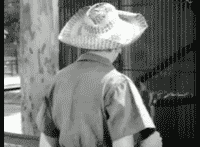Trago verdades: os
melhores cursos online sobre cinema são oferecidos pelo TCM em parceria com a Ball State University. Depois do grande
sucesso e da maravilhosa experiência de aprendizagem em 2015 com o curso
#NoirSummer, fiquei animadíssima ao descobrir que em 2016 seria oferecido o
curso #SlapstickFall. Agora seria a vez de estudar o melhor da comédia física,
e eu não poderia perder esta oportunidade. E, conforme fui aprendendo, vi
alguns paralelos com o cinema brasileiro.
Let me tell the truth: the best online film courses are offered by TCM
and Ball State University. After the massive success and wonderful learning
experience that was #NoirSummer in 2015, I became ecstatic to find out that in
2016 the course to be offered would be
themed #SlapstickFall. Now it'd be time to study the very best of slapstick,
and I couldn't miss this opportunity. And, as I learned, I could see some
things in common with Brazilian cinema.
O curso foi, obviamente,
centrado em Hollywood, com apenas um desvio para a França e as comédias de
Jacques Tati. Isso não significou que não houve filmes de comédia dignos de
nota em outros países, foi apenas uma escolha do canal, dos programadores e dos
responsáveis pelo curso. Por isso, quero apresentar um pouco da era de ouro da
comédia brasileira, não somente para os estudantes do curso, mas para todos os
interessados.
The course was, obviously, Hollywood-centered, with only a small detour
to France and Jacques Tati's comedies. This doesn't mean that there were no
worthy comedy films made in other countries, it was only a choice made by the
channel, the programmers and the ones responsible for the course. That's why I
want to show this introductory post on Brazilian slapstick, not only for
#SlapstickFall alumni, but to all that might be interested.
Nos anos 1950 e 1960, os
críticos e especialistas norte-americanos consideravam que a era de ouro da
comédia slapstick tinha sido a era do cinema mudo. O filme “Os Reis do
Riso” de 1957, surpreendentemente aponta como os mais bem-sucedidos comediantes
da época Laurel e Hardy, e isso em parte se deve ao sucesso tanto em filmes
mudos quanto falados, e à duradoura relação com o público desenvolvida por anos
e anos de reprises, em especial na televisão.
In the 1950s and 60s, critics and film connoisseurs from the US
considered that the golden age of slapstick was the silent film era. The film
“The Golden Age of Comedy”, from 1957, surprisingly points Laurel and Hardy as
the most successful comedians of the time, and this is due to two factors:
first, they were successful in both silents and talkies, and second, everybody
knew them thanks to years and years of reruns of their features and shorts, in
special on TV.
Today we have the benefit of time, and we see differently this age of
slapstick. The anthology film made in 1957 didn't even cite Chaplin, Keaton and
Lloyd, who are now considered the three biggest comedians in silent cinema.
Se a era de ouro da
comédia americana foi a década de 1920, a era de ouro das comédias brasileiras
foi a década de 1950. Um período auspicioso para o cinema como um todo, mas em
especial para o slapstick 100% verde e amarelo: as chanchadas, filmes
com humor ingênuo e vários números musicais. As chanchadas eram incrivelmente
populares, apesar de ser consideradas um gênero vulgar pelos críticos. Algumas
chanchadas eram, inclusive, paródias dos sucessos de Hollywood, como “Matar ou
Correr” (1954, figura abaixo), paródia de “Matar ou Morrer” (1952), faroeste com Gary Cooper.
If the golden age of American slapstick was the 1920s, the golden age of
Brazilian slapstick was the 1950s. It was a wonderful time for Brazilian cinema
as a whole, but better for our slapstick: the 'chanchadas', films with naïve
humor and a lot of musical numbers. The 'chanchadas' were very popular,
although they were considered a lesser, vulgar genre by critics. Some
'chanchadas' were actually parodies of Hollywood films, like “Kill or Run”
(1954, image below), a parody of “High Noon” (1952), a western with Gary Cooper.
E, assim como na
Hollywood muda, o Brasil das chanchadas também teve sua trindade cômica
principal. Os americanos tinham Chaplin, Keaton e Lloyd, nós tínhamos
Mazzaropi, Ankito e Oscarito. Obviamente, havia outros tantos comediantes na
época, com menos destaque ou cuja importância histórica diminuiu ao longo dos
anos. Os americanos tinham, entre os representantes menores do slapstick, Charley Chase, Ben Turpin,
Billy Bevan, Larry Semon, Harry Langdon, e também Mabel Normand. Os brasileiros
tinham Costinha, Arrelia, Zé Trindade, Walter D'Ávila, Mesquitinha, e também
Dercy Gonçalves.
And, just like in Hollywood, the Brazil from the 'chanchadas' also had
their Big Three in comedy. The Americans had Chaplin, Keaton and Lloyd, we had
Mazzaropi, Ankito e Oscarito. Obviously, there were many other comedians at the
time, not so successful or not so historically important. The Americans had,
among the lesser comedians, Charley Chase, Ben Turpin, Billy Bevan, Larry
Semon, Harry Langdon, and also Mabel Normand. The Brazilians had
Costiha, Arrelia, Zé Trindade, Walter D'Ávila, Mesquitinha, and also Dercy Gonçalves.
E a trindade cômica
brasileira em muito se parece com a americana! Quer
ver?
And the Brazilian Big Three had a lot in common with the American ones. Wanna see?
Charles Chaplin e Amácio
Mazzaropi faziam filmes que misturavam comédia e drama, e que mexiam com as
emoções no público. No começo da carreira, ambos estavam focados na comédia da
moda, mas anos mais tarde desenvolveram sua persona
cinematográfica, seu estilo próprio, e passaram a explorá-lo até o final de
suas carreiras. Chaplin fez isto misturando risos e lágrimas em “O Garoto”
(1921), e Mazzaropi começou a explorar mais assuntos sociais e dramas rurais a
partir de “Jeca Tatu” (1959).
Charles Chaplin and Amácio Mazzaropi both made films mixing comedy and
drama, and loved to play with the feelings of the audience. In the beginning of
their careers, both did the kind of comedy that was in vogue, but years later
they developed their film personas, an unique style, and explored it until the
end of their careers. Chaplin did it by mixing laugh and tears in “The Kid”
(1921), and Mazzaropi started exploring social issues and rural dramas after
“Jeca Tatu” (1959).
Buster Keaton e Ankito
(nascido Anchizes Pinto) eram os acrobatas. Ambos começaram a carreira fazendo
acrobacias: Buster no vaudeville, Ankito no circo. Ankito foi, inclusive, cinco
vezes campeão sul-americano de acrobacias. Nos filmes, ambos continuaram
mostrando o lado atlético e sempre recebiam os golpes da vida com uma atitude
blasé, despreocupada, até um pouco ingênua. Keaton sofreu alguns acidentes em
sua carreira, e Ankito caiu de um prédio em construção durante as filmagens de
“Um Candango na Belacap”, em 1960. Tudo sem maiores consequências. Ambos se
dedicaram à televisão no final da carreira.
Buster Keaton and Ankito (born Anchizes Pinto) were the acrobats. Both
started their careers doing acrobatics: Buster in vaudeville, Ankito at the
circus. Ankito was even South American acrobatic champion for five times. At
the movies, both showed their athletic side and always received the blows of
life with a blasé, not worried, even naïve attitude. Keaton suffered a few
accidents on set, and Ankito fell from a building during filming “Um Candango
na Belacap”, in 1960. All without big consequences. Both worked on television
later in life.
Harold Lloyd ganhou mais
dinheiro que Chaplin e Keaton. E não havia concorrência na bilheteria quando um
filme de Oscarito estava em exibição. Oscarito nasceu na Espanha, mas veio para
o Brazil com um ano de idade, e aos cinco anos entrou para o circo. Oscarito
fez uma dupla de sucesso com Grande Otelo, que se saía bem tanto no drama
quanto na comédia. Em termos de sucesso, o filme “Esse Milhão é Meu” (1959)
detém um recorde: levou 15 milhões de pessoas ao cinema, o equivalente a um
quarto da população brasileira na época.
Harold Lloyd made more money than Chaplin and Keaton. And there was no
place for anybody else when one of his films hit the theaters. Oscarito was
born in Spain, but came to Brazil at age one and at age five he joined the
circus. Oscarito was part of a successful duo with Grande Otelo, an actor
brilliant in both drama and comedy. If you consider success, the film “This is
my Million” (1959) set a record: it was watched by 15 million people, or one
quarter of the Brazilian population at the time.
Você
sabe aquele ditado: “O tempo voa quando você está se divertindo”? Foi isso que
aconteceu com o curso #SlapstickFall. E a chanchada?, vocês devem estar se
perguntando. Em 1962 a Atlântida, companhia cinematográfica mais associada ao
gênero, produziu sua última chanchada. Um dos principais nomes do Cinema Novo
brasileiro, Glauber Rocha, criticava agressivamente as chanchadas. A chanchada,
entretanto, nunca morreu: como toda boa tradição no slapstick, ela ainda
influencia o humor brasileiro.
Do you know that old saying: “Time flies when you’re having fun”? It was
exactly what happened with the #SlapstickFall course. And what about the ‘chanchada’?,
you must be asking yourselves. In 1962, Atlântida, the cinematographic company
responsible for the most ‘chanchadas’, released the last film from this genre.
One of the main names of Brazilian New Cinema, Glauber Rocha, aggressively criticized
the ‘chanchadas’. However, the ‘chanchada’ never died: as any good slapstick
tradition, it stil has an influence in Brazilian humor.






1 comment:
Very interesting. I am intrigued by these performers and their films. They sound like entertainment I would truly enjoy.
Thank you. Who knew the #SlapstickFall course would lead to you teaching me more about Brazilian cinema?
Post a Comment